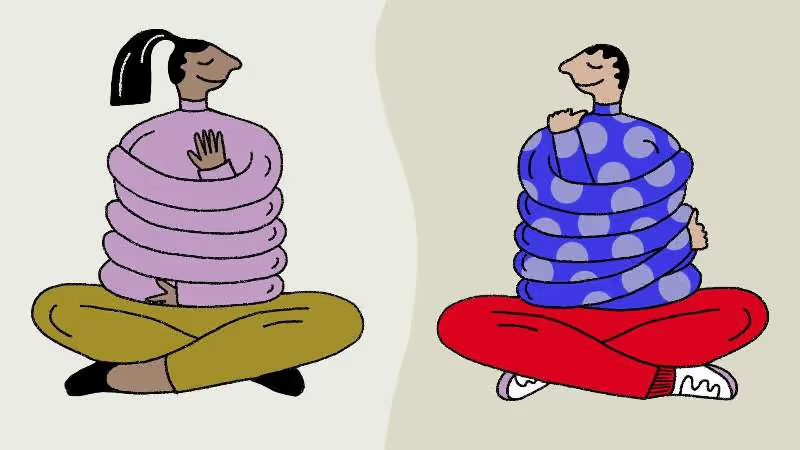Ask any American about their introduction to sex and, depending on where and how they grew up, you’re bound to hear stories involving promise rings, bananas, “down there,” and the oft-spouted main outcomes of our carnal inclinations: danger, dysfunction, and disease. This is not to say that other cultures have it all figured out—my Jewish Polish parents taught me that I came from a stork; thankfully, the Belgium education system taught me otherwise. This is, in part, why it’s so important to consider the intersecting avenues of education; a child forms their ideas about the world from what they learn at school, from their friends, and at home. I’m frequently asked, “How should I talk about sex to my little ones and when should I start? And how should that communication evolve as they grow up?”
Most countries that practice comprehensive sex education have taken a developmental approach starting at age four. Why? Because this is the age when children become natural theologians, when they ask where did we come from and where did grandma go when she died. This is also the age when children develop a separate sense of self and begin to explore how we are all connected.
Young children engage in behavior that is sexual but they don’t know that it is sexual: when Alex enters the classroom and runs to sit next to Charlie; when Alex wants to hold hands with Charlie while they walk. Or, when Alex or Charlie is by themself practicing self-touch, the most natural form of self-soothing that our little ones discover.
This is all normal behavior. It is up to the adults to help provide context. It’s not just about teaching what genitals do, but the meaning of certain behaviors and when they are private or public. Self-touch is something special you do for yourself. We don’t stroke ourselves in public in the same way that we don’t pee in front of others. We acknowledge that self-touch feels really nice, but, as Freud has said, keeping it private is the price we pay for civilization and its discontents.
Avoiding these discussions, reprimanding a child for being curious, or worse, providing misinformation, induces fear and shame and may set the child up for a lifetime of misunderstanding about sexuality and relationships. I believe that many of the troubled situations that occur among adults are a consequence of a massive vacuum people experience during youth. And it doesn’t have to be this way. It begins with expanding our definition. “Sex ed” doesn’t cut it. I prefer the phrase “Sexuality and Relationship Education.” In my many years as a cross-cultural psychotherapist, I have found that when we think of sex and relationships as exclusive from one another, we miss the opportunity to more deeply understand ourselves and our partners.
This brings us to number one on our list of how comprehensive sexuality and relationship education makes a difference.
1. It establishes integration and helps us form healthy connections.
It's taken us a while to understand that human health is an interconnected system. In the same way that we teach children physical and emotional health, sexual and relational health must be taught as an integral part of that. It isn't a second track. Our knowledge and practice of respect, responsibility, mutuality, pleasure, contraception, and consent determines the quality and consequences of the physical and emotional experience of sex. Comprehensive sexuality and relationship education teaches that it isn’t a matter of just “having” sex but that we are sexual beings. It emphasizes the importance of human connection, how to respond to our attractions and our desires and what to do with the attention from others. Teaching children sexual self-awareness helps with the creation of boundaries. When you make it about connection, you’re giving it a meaning. Sex takes place in a context. And integration allows pleasure to flourish in that context of relatedness.
2. Comprehensive sex education helps us have a healthier relationship with our bodies.
Children should be raised with a clear understanding of their bodies, how bodies work, how to take care of them, and how all bodies are unique and special and must be treated well. Why is it that we name every body part by its actual name except our genitals? Have you ever heard a nickname for knees? Or armpits? Similarly to how we spend countless nights and mornings teaching our children how to brush their teeth and hair, and why good oral health is paramount, we must also teach children how to clean their genitals, what they’re for, how they will change over time, and how to protect them. These conversations go a long way in helping a child become self-reliant in regards to health and hygiene, and help establish self-esteem. Your body is normal and beautiful and functional. It is yours and only yours. It works like this and will change like that. This is how to take care of it.
3. It normalizes sex and relationships and demystifies them.
Talking to children about sexuality early on establishes it as a normal topic, and avoids awkward and fraught interventions that inevitably occur too late. Secrecy surrounding sex breeds fear and shame, whereas appropriate openness encourages children to ask questions. It is infinitely preferable to have them ask you for answers than try to figure it out on their own only to stumble upon misinformation. And if you lead the conversation, then you can steer it in the direction of two of the most important aspects of sexual and relationship health….
4. It encourages responsibility and good judgement.
Let’s get started by dispelling an all too-common myth: teaching children about sex doesn’t make them want to start right away—they’re not going to go running from the kitchen into the sack—but it does create an expectation of responsibility and an infrastructure for how to exercise good judgement. It creates a healthy curiosity. In America, sex is the risk factor. In Europe, being irresponsible is the risk factor. America doesn’t have a public health policy on adolescent sexuality, whereas in Europe, campaigns about safe sex are as prevalent as campaigns that educate citizens about drunk driving. American campaigns like “Not Me, Not Now” encourage abstinence as a means of avoiding teen pregnancy and sexually transmitted diseases, and our public health policies reflect the idea that adolescent sexuality is deviant behavior that needs to be prevented. Our European neighbors, in contrast, view adolescent sexuality as a normal developmental stage on the way to healthy, adult sexuality. Hence the European counter-slogan to “Not Me, Not Now” is “Rights, Responsibility, Respect.”
5. Comprehensive sex education lifts us as a society.
We live in a society that is hypersexualized and woefully under-informed. We’ve really only been able to explore our sexuality freely since 1965, when the outcome of Griswold v. Connecticut reversed outlawed use of contraception by “married” couples. The democratization of contraception made way for a sexual revolution, and that revolution to this day is seen as a threat to those who think restricting access to sexual and relationship education will prevent the downfall of our society. But here is the reality: the absence of this education causes us to disassociate the physical act of sex from its consequences. A society that sees even safe sex as “soiled” is a society that thrives on sex scandals rather than sex information. Sex cannot be divorced from emotion and social continuity. We need to help reshape the narrative around sex and relationships for our young ones, and we need to start early. As Amy Schalet so cogently explains, “we see teenagers as helpless victims beset by raging hormones and believe parents should protect them from urges they cannot control… This compounds the burden on parents to steer teenage children away from relationships that will do more harm than good.” When we make sexuality and relational health clear, concrete, and contextualized for children and teens, they come out differently on the other side. Comprehensive education creates self-awareness, responsibility, and empathy. Sending kids into the world without this understanding is a threat to society as a whole.
And it shows in the data
- In 2015, the U.S. Department of Health and Human Services (HHS) compiled information from twenty-one countries and found that the U.S. had the highest rate of teen pregnancies.
- This reinforces prior findings, from 2009, by the reputable organization Advocates for Youth, which found that the United States ranks number one in teen pregnancy, birth, abortion, and STD-contraction rates, and ranks lowest in contraceptive use, as compared to France, Germany, and the Netherlands.
- Despite this, in July 2019, the HHS granted nearly $1.5 million in federal funding to organizations that promote abstinence-only education, which has been found to have significant negative impacts on adolescents.
- Whereas organizations which provide more comprehensive and diverse information about sex, relationships, and family planning, such as Planned Parenthood, continue to be under threat.
I encourage you to celebrate World Sexual Health Day by examining the ways in which you’ve been taught about sex and relationships and to take a deeper look at what you can do to be a part of a global solution toward sexual health. It starts small—a conversation at home with a young, loved one makes a huge difference.
Children's books about sex and relationships
- Cory Silverberg’s books: Sex is a Funny Word; What Makes a Baby; The Ultimate Guide to Sex and Disability
- It’s Perfectly Normal by Robbie Harris
- S.E.X.: The All-You-Need-To-Know Progressive Sexuality by Heather Corinna
- Beyond the Big Talk: Every Parent's Guide to Raising Sexually Healthy Teens, from Middle School to High School and Beyond by Debra W. Haffner
Additional resources for adults
- Not Under My Roof: Parents, Teens, and the Culture of Sex by Amy Schalet
- “The Sex Ed” podcast - Episode 30 with Dr. Rachel Ross
- Sex Education: Last Week Tonight with John Oliver (HBO)
- California approves new guidance for teaching sex education (May 2019)
- Women's Anatomy of Arousal: Secret Maps to Buried Pleasure by Sheri Winston
- Mary Roach’s TED Talk on Orgasms
- Come as You Are: The Surprising New Science that Will Transform Your Sex Life by Emily Nagoski
- The New Male Sexuality by Bernie Zilbergeld
- She Comes First: The Thinking Man's Guide to Pleasuring a Womanby Ian Kerner
- Sexual Reflections: A Workbook for Designing and Celebrating Your Sexual Health Plan
- by Alexandra Katehakis
- From Diapers to Dating: A Parent’s Guide to Raising Sexually Healthy Children by Debra W. Haffner
- Everything You Never Wanted Your Kids to Know About Sex (But Were Afraid They’d Ask): The Secrets to Surviving Your Child’s Sexual Development from Birth to the Teens. By Justin Richardson and Mark Schuster
- Planned Parenthood website for sex education
- AASECT’s website and resources for finding a sex therapist
- SSTAR’s website and resources for finding a sex therapist







.svg)





